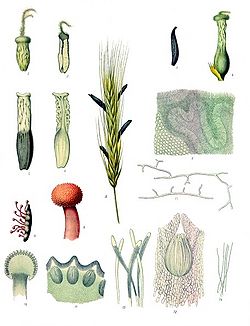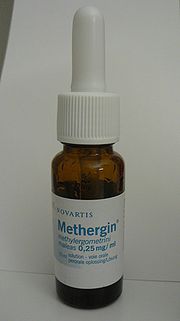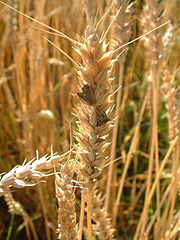Ergot
| Ergot Poison | ||||||||||||
|---|---|---|---|---|---|---|---|---|---|---|---|---|
 Claviceps purpurea
|
||||||||||||
| Scientific classification | ||||||||||||
|
||||||||||||
| Species | ||||||||||||
|
About 50, including: |
Ergot is the common name of a fungus in the genus Claviceps that is parasitic on certain grains and grasses. The fungus forms a sclerotium in winter, and this small structure is what is usually referred to as 'ergot', although referring to the members of the Claviceps genus as 'ergot' is also correct. There are about 50 known species of Claviceps, most of them in the tropical regions. Economically important species are Claviceps purpurea (parasitic on grasses and cereals), C. fusiformis (on pearl millet, buffel grass), C. paspali (on dallis grass), and C. africana[1](on sorghum). C. purpurea can affect a number of cereals including rye (its most common host), triticale, wheat and barley. It affects oats only rarely.
There are three races or varieties of C. purpurea, differing in their host specificity:[2]
- G1 — land grasses of open meadows and fields;
- G2 — grasses from moist, forest, and mountain habitats;
- G3 (C. purpurea var. spartinae) — salt marsh grasses (Spartina, Distichlis).
Contents |
Life cycle
An ergot kernel called a sclerotium develops when a floret of flowering grass or cereal is infected by a spore of fungal species of the genus Claviceps. The infection process mimics a pollen grain growing into an ovary during fertilization. Because infection requires access of the fungal spore to the stigma, plants infected by Claviceps are mainly outcrossing species with open flowers, such as rye (Secale cereale) and ryegrasses (genus Lolium). The proliferating fungal mycelium then destroys the plant ovary and connects with the vascular bundle originally intended for seed nutrition. The first stage of ergot infection manifests itself as a white soft tissue (known as sphacelia) producing sugary honeydew, which often drops out of the infected grass florets. This honeydew contains millions of asexual spores (conidia) which are dispersed to other florets by insects. Later, the sphacelia convert into a hard dry sclerotium inside the husk of the floret. At this stage, alkaloids and lipids accumulate in the sclerotium.
Claviceps species from tropic and subtropic regions produce macro- and microconidia in their honeydew. Macroconidia differ in shape and size between the species, whereas microconidia are rather uniform, oval to globose (5x3μm). Macroconidia are able to produce secondary conidia. A germ tube emerges from a macroconidium through the surface of a honeydew drop and a secondary conidium of the oval to pearlike shape is formed to which the contents of the original macroconidium migrates. Secondary conidia form white frost-like surface on honeydew drops and are spread by wind. No such process occurs in Claviceps purpurea, Claviceps grohii, Claviceps nigricans, and Claviceps zizaniae, all from Northern temperate regions.
When a mature sclerotium drops to the ground, the fungus remains dormant until proper conditions trigger its fruiting phase (onset of spring, rain period, etc.). It germinates, forming one or several fruiting bodies with head and stipe, variously colored (resembling a tiny mushroom). In the head, threadlike sexual spores are formed, which are ejected simultaneously, when suitable grass hosts are flowering. Ergot infection causes a reduction in the yield and quality of grain and hay produced, and if infected grain or hay is fed to livestock it may cause a disease called ergotism. Black and protruding sclerotia of C. purpurea are well known. However, many tropical ergots have brown or greyish sclerotia, mimicking the shape of the host seed. For this reason, the infection is often overlooked.
Effects on humans and animals

The ergot sclerotium contains high concentrations (up to 2% of dry mass) of the alkaloid ergotamine, a complex molecule consisting of a tripeptide-derived cyclol-lactam ring connected via amide linkage to a lysergic acid (ergoline) moiety, and other alkaloids of the ergoline group that are biosynthesized by the fungus.[3] Ergot alkaloids have a wide range of biological activities including effects on circulation and neurotransmission.[4]
Ergotism is the name for sometimes severe pathological syndromes affecting humans or animals that have ingested ergot alkaloid-containing plant material, such as ergot-contaminated grains. The common name for ergotism is "St. Anthony's Fire", in reference to the symptoms, such as severe burning sensations in the limbs.[5] These are caused by effects of ergot alkaloids on the vascular system due to vasoconstriction of blood vessels, sometimes leading to gangrene and loss of limbs due to severely restricted blood circulation. The neurotropic activities of the ergot alkaloids may also cause hallucinations and attendant irrational behaviour, convulsions, and even death.[3][4] Other symptoms include strong uterine contractions, nausea, seizures, and unconsciousness. Historically, controlled doses of ergot were used to induce abortions and to stop maternal bleeding after childbirth. Ergot alkaloids are also used in products such as Cafergot (containing caffeine and ergotamine or ergoline) to treat migraine headaches. Ergot extract is no longer used as a pharmaceutical preparation. Monks of the order of St. Anthony the Great specialized in treating ergotism victims with balms containing tranquilizing and circulation-stimulating plant extracts; they were also skilled in amputations.
In addition to ergot alkaloids, Claviceps paspali also produces tremorgens (paspalitrem) causing "paspalum staggers" in cattle. Ergot alkaloids are also produced by fungi of the genera Penicillium and Aspergillus, notably by some isolates of the human pathogen Aspergillus fumigatus,[6] and have been isolated from plants in the family Convolvulaceae, of which morning glory is best known.
Ergot contains no lysergic acid diethylamide (LSD) but instead contains ergotamine, which is used to synthesize lysergic acid, an analog of and precursor for synthesis of LSD. Moreover, ergot sclerotia naturally contain some amounts of lysergic acid.[7]
In the January 4, 2007 issue of the New England Journal of Medicine, a paper was published documenting a British study of over 11,000 Parkinson's Disease patients. The study found that two ergot-derived drugs, Pergolide and Cabergoline, commonly used to treat Parkinson's Disease may increase the risk of leaky heart valves by up to 700%.[8]
Speculations

The disease cycle of the ergot fungus was first described in the 1800s, but the connection with ergot and epidemics among people and animals was known several hundred years before that.
Human poisoning due to the consumption of rye bread made from ergot-infected grain was common in Europe in the Middle Ages. The epidemic was known as Saint Anthony's fire, or ignis sacer.
Linnda R. Caporael posited in 1976 that the hysterical symptoms of young women that had spurred the Salem witch trials had been the result of consuming ergot-tainted rye.[9] However, her conclusions were later disputed by Nicholas P. Spanos and Jack Gottlieb, after a review of the historical and medical evidence.[10] Other authors have likewise cast doubt on ergotism having been the cause of the Salem Witch Trials.[11] The Canadian cereal fly discovered by the Canadian professor Sir Leighton carries the fungus like a bee carries pollen and lives in the Salem area.
The Great Fear in France during the Revolution has also been linked by some historians to the influence of ergot.
British author John Grigsby claims that the presence of ergot in the stomachs of some of the so called 'bog-bodies' (Iron Age human remains from peat bogs N E Europe such as Tollund Man), reveals that ergot was once a ritual drink in a prehistoric fertility cult akin to the Eleusinian Mysteries cult of ancient Greece. In his book Beowulf and Grendel he argues that the Anglo-Saxon poem Beowulf is based on a memory of the quelling of this fertility cult by followers of Odin. He states that Beowulf, which he translates as barley-wolf, suggests a connection to ergot which in German was known as the 'tooth of the wolf'.
Kykeon, the beverage consumed by participants in the ancient Greek cult of Eleusinian Mysteries, might have been based on hallucinogens from ergot.[12]
Currently, rye grain is infected to produce ergot sclerotia. Male sterile rye is often used, as the pollen from fertile rye competes with the fungal conidia.
References
- ↑ [1]
- ↑ [2]
- ↑ 3.0 3.1 Tudzynski P, Correia T, Keller U (2001). "Biotechnology and genetics of ergot alkaloids". Appl Microbiol Biotechnol. 57: 4593–4605. doi:. PMID 11778866.
- ↑ 4.0 4.1 Eadie MJ (2003). "Convulsive ergotism: epidemics of the serotonin syndrome?". Lancet Neurol. 2: 429–434. doi:. PMID 12849122.
- ↑ [3]
- ↑ Rao KK, Rao S (1975). "Effect of tweens on the production of ergot alkaloids by Aspergillus fumigatus". Folia Microbiol. 20: 418–422. doi:. PMID 1104424.
- ↑ Correia T, Grammel N, Ortel I, Keller U, Tudzynski P. (2001). "Molecular cloning and analysis of the ergopeptine assembly system in the ergot fungus Claviceps purpurea". Chem Biol. 10: 1281–1292. doi:. PMID 14700635.
- ↑ NEJM - Dopamine Agonists and the Risk of Cardiac-Valve Regurgitation
- ↑ "Ergotism: The Satan Loosed in Salem?", Science Vol. 192 (2 April 1976), pp. 21-26. See: http://web.utk.edu/~kstclair/221/ergotism.html
- ↑ "Ergotism and the Salem Village Witch Trials", Science, Volume 194, Issue 4272, pp. 1390-1394
- ↑ Woolf A (2000). "Witchcraft or mycotoxin? The Salem witch trials". J Toxicol Clin Toxicol 38: 457–460. doi:. PMID 10930065.
- ↑ "Mixing the Kykeon", ELEUSIS: Journal of Psychoactive Plants and Compounds, New Series 4, 2000
External links
- Claviceps purpurea - Ergot Alkaloid
- Ergot article from North Dakota State University, 2002
- Abundant Respirable Ergot Alkaloids from the Common Airborne Fungus Aspergillus fumigates
- PBS Secrets of the Dead: "The Witches Curse" (concerning the Salem trials and ergot)
- New England Journal of Medicine - Dopamine Agonists and the Risk of Cardiac-Valve Regurgitation
- HealthDay - Parkinson's Drugs Can Damage Heart Valves
|
||||||||||||||